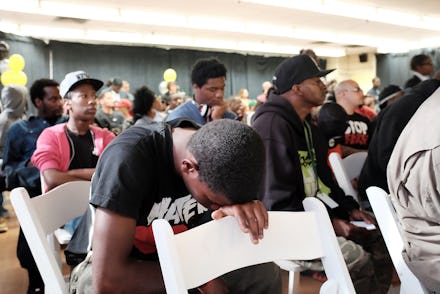Black teen boys 19 times more likely to be killed by homicide than white boys in US, UNICEF reports

A new UNICEF report on violence against children worldwide finds that homicide continues to harm non-Hispanic black adolescent boys in America nearly 19 times more than white adolescent boys. The alarming stat is comparable to the risks of homicide adolescents face in “war-torn” countries.
“In 2015, the risk of being killed by homicide for a non-Hispanic black adolescent boy in the United States was the same as the risk of being killed due to collective violence for an adolescent boy living in war-torn South Sudan,” UNICEF wrote Wednesday.
Non-Hispanic adolescent black girls face a risk of homicide that is nearly five times that of non-Hispanic white adolescent girls, according to the report.
Black youth in big cities across the country have been facing a decades-long crisis of homicide by gun violence in their communities. For instance, in January, the Chicago Police Department reported that there were 1,100 more shooting incidents in 2016 than in 2015. The majority of these killings were in predominantly black communities. Much of the violence in the city is attributed to gangs.
In New York City, homicides dropped from 352 to 335 between 2015 and 2016, according to the New York Police Department. Black people were 57.5% of murder and non-negligent manslaughter victims in 2016, compared to 63.7% in 2015. Although there were fewer reported murders for black people, they are still more likely to be murdered in the New York City than people of other races are.
Several other cities have reported racial disparities among homicide victims in the past year or so. In Charlotte, North Carolina, the number of homicides in 2017 — 73 — surpassed 2016’s 67 victims by October. Four out of five victims are black. The city of Richmond, Virginia, saw the highest homicide rate in over a decade in 2016. Of the victims, 81% were black.
Much of the violence male youth face worldwide is from strangers, UNICEF reports. In the U.S., victims of violence are usually attacked by individuals of their same race. And not only will black youth face violence within their community, but black youth face it as well from police. A 2016 GenForward poll found that two out of three black youth have been or know someone who has been harassed by the police.
Even in school environments, black students are targeted by disproportionate school suspensions in districts nationwide. Black girls are twice as likely to be suspended than white girls, according to a May National Women’s Law Center study. Another report from the U.S. Department of Education found that black boys are 10% more likely to be suspended than white boys. In 2015, research from Center for the Study of Race and Equity in Education at the University of Pennsylvania, revealed 55% of black student suspensions were happening in 13 Southern states.
“In 132 Southern school districts, blacks were disproportionately suspended at rates five times or higher than their representation in the student population,” Edward Smith and Shaun Harper, the authors of the University of Pennsylvania report, wrote.
The UNICEF report includes recommendations to aid in decreasing the violence against youth worldwide. Some of these proposed solutions are to “address factors that contribute to violence against children including economic and social inequities;” “focusing national policies on minimizing violent behavior;” and collecting recurring data on these stats to track progress and areas that need continued intervention.